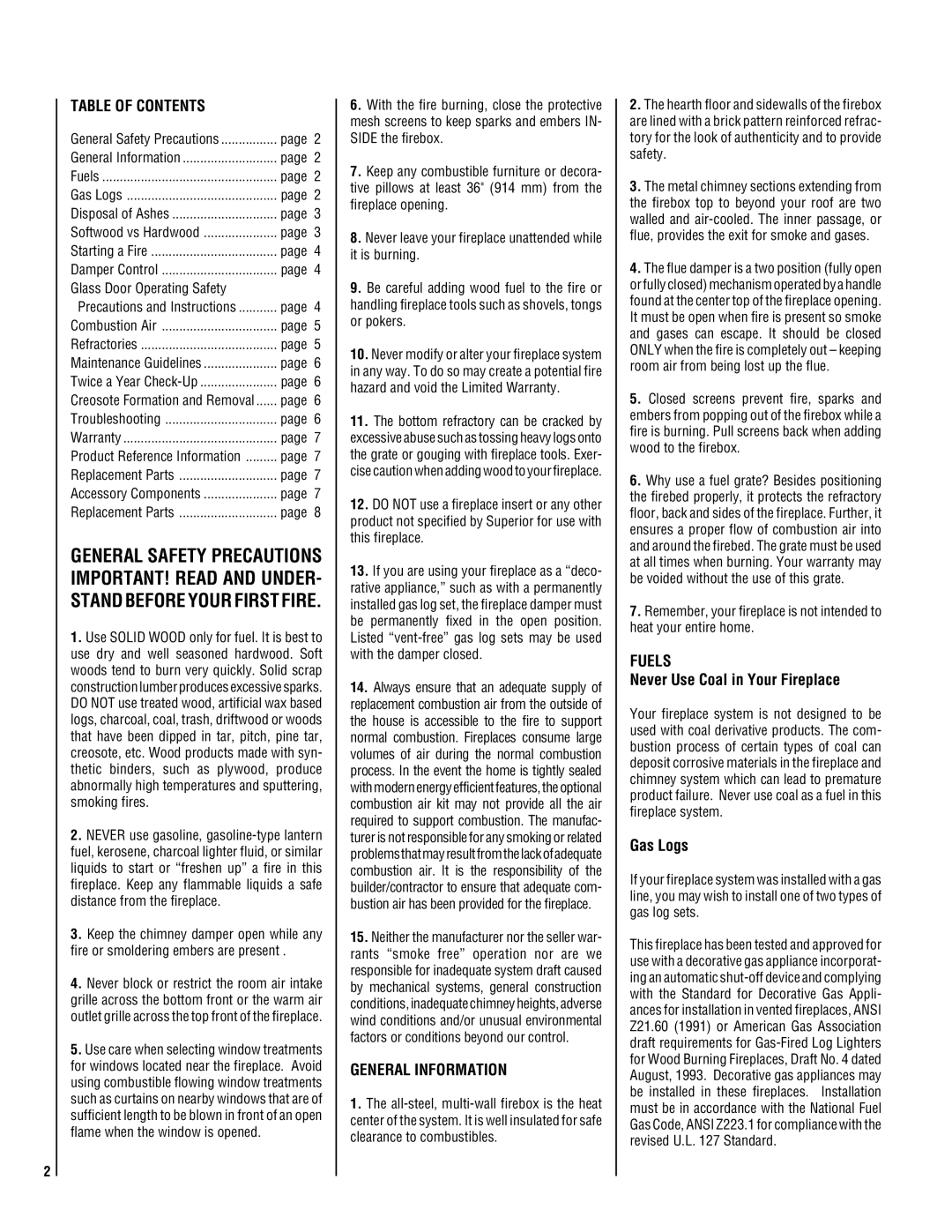
2
TABLE OF CONTENTS |
|
|
General Safety Precautions | page | 2 |
General Information | page | 2 |
Fuels | page | 2 |
Gas Logs | page 2 | |
Disposal of Ashes | page | 3 |
Softwood vs Hardwood | page 3 | |
Starting a Fire | page | 4 |
Damper Control | page 4 | |
Glass Door Operating Safety |
|
|
Precautions and Instructions | page | 4 |
Combustion Air | page 5 | |
Refractories | page | 5 |
Maintenance Guidelines | page | 6 |
Twice a Year | page 6 | |
Creosote Formation and Removal | page 6 | |
Troubleshooting | page | 6 |
Warranty | page 7 | |
Product Reference Information | page | 7 |
Replacement Parts | page 7 | |
Accessory Components | page 7 | |
Replacement Parts | page 8 | |
GENERAL SAFETY PRECAUTIONS IMPORTANT! READ AND UNDER- STAND BEFORE YOUR FIRST FIRE.
1.Use SOLID WOOD only for fuel. It is best to use dry and well seasoned hardwood. Soft woods tend to burn very quickly. Solid scrap construction lumber produces excessive sparks. DO NOT use treated wood, artificial wax based logs, charcoal, coal, trash, driftwood or woods that have been dipped in tar, pitch, pine tar, creosote, etc. Wood products made with syn- thetic binders, such as plywood, produce abnormally high temperatures and sputtering, smoking fires.
2.NEVER use gasoline,
3.Keep the chimney damper open while any fire or smoldering embers are present .
4.Never block or restrict the room air intake grille across the bottom front or the warm air outlet grille across the top front of the fireplace.
5.Use care when selecting window treatments for windows located near the fireplace. Avoid using combustible flowing window treatments such as curtains on nearby windows that are of sufficient length to be blown in front of an open flame when the window is opened.
6.With the fire burning, close the protective mesh screens to keep sparks and embers IN- SIDE the firebox.
7.Keep any combustible furniture or decora- tive pillows at least 36" (914 mm) from the fireplace opening.
8.Never leave your fireplace unattended while it is burning.
9.Be careful adding wood fuel to the fire or handling fireplace tools such as shovels, tongs or pokers.
10.Never modify or alter your fireplace system in any way. To do so may create a potential fire hazard and void the Limited Warranty.
11.The bottom refractory can be cracked by excessive abuse such as tossing heavy logs onto the grate or gouging with fireplace tools. Exer- cise caution when adding wood to your fireplace.
12.DO NOT use a fireplace insert or any other product not specified by Superior for use with this fireplace.
13.If you are using your fireplace as a “deco- rative appliance,” such as with a permanently installed gas log set, the fireplace damper must be permanently fixed in the open position. Listed
14.Always ensure that an adequate supply of replacement combustion air from the outside of the house is accessible to the fire to support normal combustion. Fireplaces consume large volumes of air during the normal combustion process. In the event the home is tightly sealed with modern energy efficient features, the optional combustion air kit may not provide all the air required to support combustion. The manufac- turer is not responsible for any smoking or related problemsthatmayresultfromthelackofadequate combustion air. It is the responsibility of the builder/contractor to ensure that adequate com- bustion air has been provided for the fireplace.
15.Neither the manufacturer nor the seller war- rants “smoke free” operation nor are we responsible for inadequate system draft caused by mechanical systems, general construction conditions, inadequate chimney heights, adverse wind conditions and/or unusual environmental factors or conditions beyond our control.
GENERAL INFORMATION
1.The
2.The hearth floor and sidewalls of the firebox are lined with a brick pattern reinforced refrac- tory for the look of authenticity and to provide safety.
3.The metal chimney sections extending from the firebox top to beyond your roof are two walled and
4.The flue damper is a two position (fully open or fully closed) mechanism operated by a handle found at the center top of the fireplace opening. It must be open when fire is present so smoke and gases can escape. It should be closed ONLY when the fire is completely out – keeping room air from being lost up the flue.
5.Closed screens prevent fire, sparks and embers from popping out of the firebox while a fire is burning. Pull screens back when adding wood to the firebox.
6.Why use a fuel grate? Besides positioning the firebed properly, it protects the refractory floor, back and sides of the fireplace. Further, it ensures a proper flow of combustion air into and around the firebed. The grate must be used at all times when burning. Your warranty may be voided without the use of this grate.
7.Remember, your fireplace is not intended to heat your entire home.
FUELS
Never Use Coal in Your Fireplace
Your fireplace system is not designed to be used with coal derivative products. The com- bustion process of certain types of coal can deposit corrosive materials in the fireplace and chimney system which can lead to premature product failure. Never use coal as a fuel in this fireplace system.
Gas Logs
If your fireplace system was installed with a gas line, you may wish to install one of two types of gas log sets.
This fireplace has been tested and approved for use with a decorative gas appliance incorporat- ing an automatic
